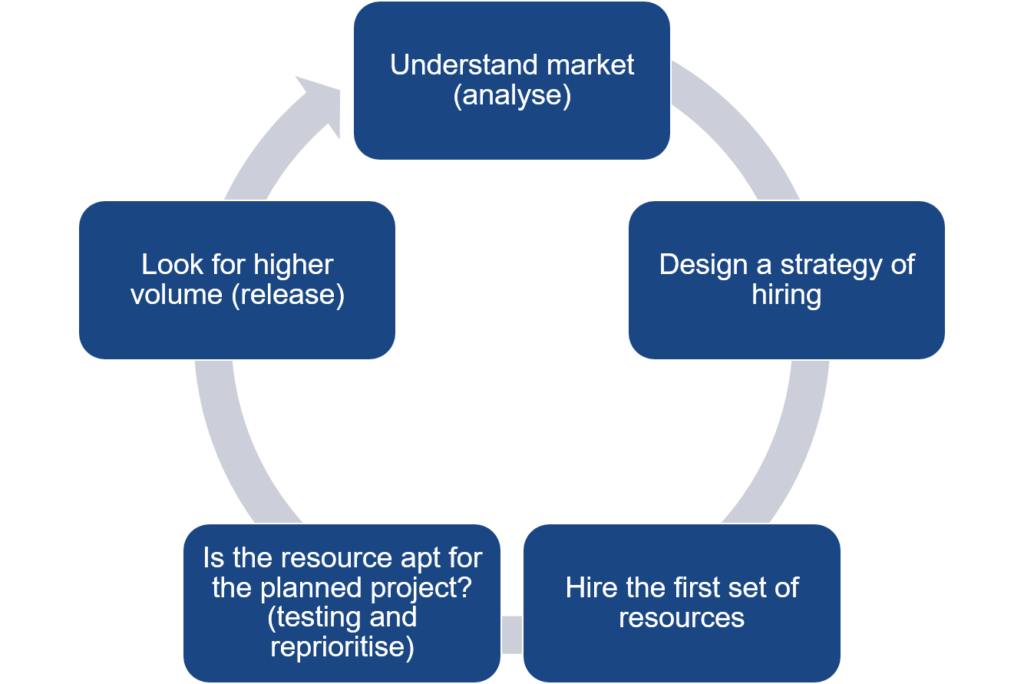Exploring the Difference Between Agile and Lean Six Sigma Recruiting
Blog
.

Recruitment Team Lead
Imagine you are at a tech talk or a talent meeting, where people throw around buzzwords and jargon like “We are agile!” and “We follow lean principles!” What do these terms actually mean? How can I apply them to specific business challenges? While these terms are often used loosely, lean principles and agile methods are important to understand and have significant impacts in the realm of recruitment.
Let’s define the buzzwords
Agile is a development methodology commonly used in IT practices, including software development and project management. To apply this methodology, a team engages in an incremental and iterative process of assigning and executing tasks. The agile process poses many benefits when applied to recruiting practices as it enables teams to be collaborative rather than responsive.
Lean Six Sigma is a methodology designed to enable process improvement across many verticals. The ideology aims to eliminate waste at every step/stage and ensure workflows are running at optimal productivity. Lean ensures that every step of the process is efficient with the fastest cycle times possible. We apply this to many processes within the recruiting and hiring experience for both hiring managers and candidates.
Understanding Agile
Under an agile mindset, teams take an iterative approach to the recruitment tasks, allowing agile principles to influence project decisions. For example, a customer needs a high volume of candidates skilled in specific advanced technologies, however, the supply of this talent is very low. The limited number of available candidates is likely due to candidates’ lack of specific experience with requested technologies.
By following an agile approach, the team can identify the limited supply of skills in the market at the initial requisition intake stage and can partner with the hiring manager to identify similar technologies, alternative skills, or opportunities to upskill their in-house pool.
Hiring niche, or hard-to-find, skillsets with an agile approach:

Applying Lean Six Sigma
TIMWOODs is an acronym used within Lean Six Sigma as a guide to the concept’s foundational principles. The acronym represents seven type of waste that should be eliminated through Lean Six Sigma for Transport, Inventory, Motion, Waiting, Over production, Over processing, Defects, and Skills. The table below defines each of these wastes as they apply to the recruitment process.
| Type of Waste | Sample recruitment process flow |
| Transport | Interview process – Time taken for each level of assessment |
| Inventory | High volume of resumes expectation, impractical projection of roles required |
| Motion | Time spent on non-value add administrative tasks, paperwork, tracking of mail trails |
| Waiting | Escalations/Approvals, Waiting for feedback, Indecision on Hold prospects |
| Over-production | Candidate pipeline without knowing the need, spend on research without the actual need analysis, various combination of skills |
| Over-processing | Different process for same skills hiring needs, tracking of same details on ATS and manual reports, Incorrect job description, improper stakeholder buy-in, involvement of too many interviewers, gaps in understanding of the level of roles required. |
| Defects | Role gap, wrong supplier identification which leads to high billing assumption |
| Skills | Misalignment/underutilization of available in-house workers who can be trained |
The best solution depends on each situation
Recruitment is a people-oriented experience based on predefined processes, but the way it is approached can yield very different results. Leading with a people-over-process approach creates a positive experience for both candidates and hiring managers.
So which is right for you: Agile recruitment or applying Lean Six Sigma principles? There are certainly advantages to both. If you have a predefined set of roles that you hire for on a regular basis, Lean Six Sigma can help to make the recruitment process more efficient by eliminating waste at each step. If there are niche or new skillsets a company is targeting to hire, Agile is the way. In the end, both methodologies should foreground the perspective of people over process.
Related Post
Industry conference ERERC 2019 was hosted in San Diego this year and it was a meeting of the minds between great recruiting gurus, sourcing experts and many more.
Hear from Josh Winwright on his experience at the conference and shares ...
Similar Resources
Lee Baldwin Global Head Financial Services
By now, your company and its services have likely been impacted by the Coronavirus pandemic. Many companies have made the shift to remote work for ...
Josh Winright Emerging Tech Business Partner
We’ve long had tools to help the recruitment process be more efficient in times where we may not have the capability to do everything in ...




